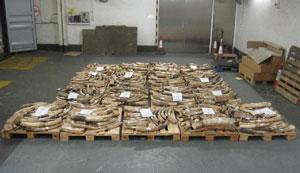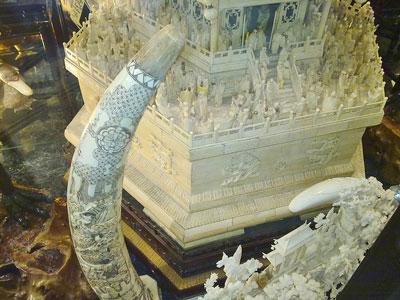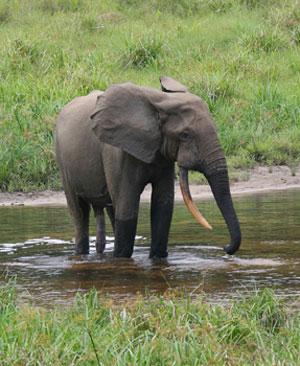Wildlife-based tourism is vital to the economy of several African nations, but a surging demand for ivory is putting some elephant populations at risk. Can the animals in and out of the continent's national parks survive the combined power of poachers, ivory markets and the Internet?
A big lure for foreign tourists headed for Africa's national parks is the hope of spotting as many as possible of the "Big Five"'usually defined as the African elephant, lion, rhinoceros, Cape buffalo, and leopard. Two of those species, the elephant and rhinoceros, are literally under the gun due to a sharp increase in poaching, and the driving force behind the uptick in illegal hunting is a soaring market for ivory.
If there's any good news in the situation, it's the lack thus far of threats to tourists drawn to Africa's national parks for a first-hand look at wildlife. Unfortunately, it's a much different story for the animals themselves, and those working to protect the parks and the wildlife.
As we noted in yesterday's Traveler, recent research has documented a "devastating 62 percent decline" in the population of African forest elephants in less than a decade. Although the forest elephants in central and western have been the hardest hit, poaching of the animals is on the rise across much of Africa, and national parks in many nations are being impacted by the trend.
What's behind this upsurge in ivory-related crime? Just follow the money.
Ivory Demand Fueling Surge in Poaching
Why is ivory such a hot commodity? It's a complex question, and the lure of ivory is deeply rooted in many cultures, but a quick explanation for the current surge in price-driven poaching is found in the expression, "just follow the money."
The return on many types of investments has been down in recent years, but one notable exception is ivory, commonly referred to in the marketplace as "white gold." There's no shortage of buyers across the globe for "worked ivory," which is the term for the substance once it's converted to everything from chop sticks to trinkets to elaborately carved works of art. In today's world, of course, you can buy almost anything without leaving home.
According to the Environmental Investigation Agency (EIA), about 80 percent of the elephant ivory ads on Google Japan's Shopping site are for "hanko," Japanese name seals used to affix signatures to documents. In the aggregate, hanko sales can account for a lot of ivory. For serious investors the lure is in fine pieces of carved art, and elaborate items can command prices well into six figures.
The supply of legally obtained ivory (which we'll define as ivory which isn't stolen or poached) isn't enough to satisfy demand, so long before product makes it to the retail market, some of it passes through a murky supply chain, with plenty of money to be made along the way.
Ivory Prices Are Soaring
According to the Convention on International Trade in Endangered Species of Wild Fauna and Flora (CITES), the cost of raw ivory on the illicit market doubled between 2002 and 2004, from $150 to $300 per kilogram. By the end of 2010, typical prices had reached $700 a kilogram'in U. S. terms that's over $300 a pound. In China, the world's largest market for ivory, the price of the raw product jumped from $270 a pound in 2011 to $900 per pound in October 2012.
Potential profits of that magnitude inevitably attract plenty of attention, and wildlife poaching is no longer a "backyard crime" by local villagers. Officials across the globe are increasingly concerned about the impacts on both wildlife and international security.
The International Conservation Caucus Foundation (ICCF) says, "The recent rise in wildlife product prices has been met by the increased involvement of more organized, better funded, and better armed criminal and terrorist networks, and even militias, compounding the challenges faced by those charged with protecting the wildlife."
Officials Say Ivory Profits Are Funding Terrorism
"Ivory and rhino horn are gaining popularity as a source of income for some of Africa's most notorious armed groups, including Somalia's al-Shabab, the Lord's Resistance Army (L.R.A.), and Darfur's janjaweed. Illegal wildlife products are a substantial lifeline to African-based terrorism," the ICCF says. "These groups, which are systematically exploiting porous borders and weak governance and hindering sustainable economic activities, have the potential to set back African development by decades and create large swaths of ungovernable land, and new hotbeds for terrorist cells."
The "professionalization of poaching" has serious ramifications for national parks in Africa. According to the ICFF, "Organized crime has led to the militarization of poaching operations and leaves African park rangers chronically outgunned by well-armed and well-financed poachers."
Impacts of the Ivory Trade on National Parks
How much impact is ivory-driven poaching having on national parks in Africa? Although parks and other officially-designated protected areas offer better protection for wildlife than other parts of the continent, such areas are no longer as insulated from poachers as they were even a few years ago. 'Ivory demand and prices have reached a point at which poachers are willing to target well protected, closely monitored populations,' said Dr. Douglas Hamilton, founder of the Kenya-based conservation group Save the Elephants. 'This is now being replicated in other protected areas across Africa.'
Yesterday's story on the Traveler cited several examples of park-based poaching, including a reported loss of as many as two-thirds of the elephants in Gabon's Minkebe National Park over the past eight years. The Gabonese park had been home to perhaps half of the continent's remaining forest elephants.
In another recent incident, 22 elephants'18 adults and four calves'were killed in Garamba National Park in the Democratic Republic of Congo within a period of two days. Information from a park official about this attack offers further confirmation about the challenges faced by those battling the illegal hunting.
"As Garamba is located in a politically volatile region, with armed forces from a number of countries as well as the Lord's Resistance Army present in the region, follow-up operations will be difficult. However, as with last year's elephant poaching incident at Zakouma National Park in Chad, we are determined to demonstrate that poaching does not pay."
Is the Poaching Problem Spreading?
Although the biggest problems are currently occurring in central Africa, the well-established national parks in countries such as Kenya aren't exempt. In January 2013 a Kenya government official stated, "We lost at least 360 elephants last year, one of the highest recorded in recent years. This was an increase from at least 289 elephants killed in 2011. The danger seems to be worsening with every passing day."
In a highly publicized incident in January 2013, an entire family of 12 savannah elephants were shot and killed in Kenya's Tsavo East National Park. Tourism to national parks is a major factor in Kenya's economy, and the Tsavo incident prompted a quick response from Raila A. Odinga, the nation's Prime Minister.
"Our wildlife, which is one of our most important sources of income as a nation, and almost the sole source of our earnings from tourism, has come under serious assault from poachers in recent days," the Prime Minister said. Mr. Odinga pledged action by his country, noting, "We have a duty to secure our precious wildlife for posterity and continued economic well-being of our nation.... We must respond to this growing threat in a big way and we must respond fast."
The Kenyan official also recognized that this is a problem that can't be solved by individual nations. " I also appeal to the international community to help strengthen the national and international policing to deal with wildlife trafficking as a serious threat to conservation, rule of law, governance and economic development," he said.
Can the Problem be Fixed?
So, what can be done about the problem? It's a complicated challenge, and solutions include better enforcement at all levels of the ivory supply chain. Most large shipments of illicit ivory move by sea from ports in eastern Africa to destinations in the Orient, and the sheer volume of that traffic makes detection and interdiction difficult. Another approach to the problem centers on efforts to slow the demand for ivory, and China and Thailand, the two largest markets for ivory, hold both promise and enormous challenges.
Growing economies throughout Asia, and in China in particular, have created a vast pool of consumers with new-found income and a desire for consumer goods, including ivory. Domestic trade in ivory is legal countries such as China and Thailand, a fact that greatly complicates enforcement efforts for illicit goods.
Demand Far Exceeds Supply
Published sources point out that the amount of raw ivory available from legal sources falls far short of the quantity needed to account for newly worked ivory goods coming into the marketplace. Research by the Environmental Investigation Agency suggests 90 percent of the ivory traded in China comes from illegal suppliers, and half of all the seizures of large shipments of illegal ivory between 2009 and 2011 occurred in China.
A key to reducing demand may lie in efforts to educate consumers in Asian countries about how ivory is actually obtained. A survey conducted by IFAW in China found that 70 percent of those questioned believe that tusks simply fall off of living elephants, and can then be simply collected without any harm to the animal. It's hoped that demand will drop if purchasers understand that about a third of a tusk is permanently attached inside the elephant's head, and the entire tusk can't be removed without a brutal death of the animal.
Enlisting Help from the Stars
Conservation groups are also enlisting the help of some big-name celebrities in their education campaign. The conservation group Save the Elephants hosted a visit to Kenya by one of China's best-known sports figures, former NBA star Yao Ming. After seeing the results of elephant poaching first-hand, Ming posted an emotional statement on his blog, asking "Would anyone buy ivory if they had witnessed this?"
Natalie Glebova, Miss Universe 2005, is a supporter of the World Wildlife Fund, and she made an appearance last week at the CITES conference in Bangkok. Britain's Prince William sent a video message to delegates at the CITES conference currently underway in Thailand, and called on world leaders to take stronger action against illegal ivory trade.
Is a Total Trade Ban the Answer?
Yet another approach to stemming ivory demand are calls from a number of groups for a total ban on all trading of ivory. Although existing agreements impose restrictions on international trades, there are significant gaps in the measures created by legal ivory markets in a number of nations. Conservation groups point out that those legal markets make it easy to "launder" illegal ivory and convert it to legitimate sales.
There's no question current restrictions on trading ivory are confusing. During the 1970s and 1980s, the elephant population in Africa was reduced by about one-half due primarily to ivory-driven poaching. In 1989 delegates to a CITES meeting from 115 nations agreed to a ban on the international trade of ivory. Not all nations decided to participate, and this ban did not affect the domestic sale and use of ivory.
It appears those restrictions were effective. Following the ban, the black market price of ivory plummeted, animal losses to poaching decreased dramatically and elephants populations stabilized to the extent that some nations in South Africa had more elephants that they wanted.
Previous Easing of Trade Bans May Have Hurt
As a result of that success, CITES approved two sales of ivory from government-owned stockpiles obtained from confiscating illegal ivory and from elephants who died of natural causes or been legally killed. Those sales in 1999 and 2008 resulted in the transfer of over 346,000 pounds of raw ivory from several south African countries to China and Japan, in the hope this legal supply would satisfy demand and continue to discourage poaching.
Many believe the opposite has occurred, and the infusion of "legal" ivory has simply bolstered demand'and provided a convenient cover for the laundering of massive amounts of illegal goods. According to CITES, illegal ivory trade activity is now over three times larger than it was in 1998, when the first of the two stockpile sales was allowed.
Some Wins for the Good Guys
Occasional victories are being won against the poachers and smugglers, but they also illustrate the scope of the problem.

A large shipment of illegal ivory intercepted in Hong Kong last October. Photo courtesy of Hong Kong Customs.
In October 2012 customs officials in Hong Kong launched a joint anti-smuggling operation with their counterparts from China. Acting on a tip, officials inspected a shipping container from Tanzania declared as containing "plastic scrap." Inside the bags of scraps they found 972 pieces of raw ivory tusks and 1.4 kilograms of ivory ornaments.
On the following day, a similar shipping container full of "roscoco beans" from Kenya was also found to carry 237 pieces of raw ivory tusks weighing about 1,884 kilograms. Total take from just two containers: Over 7,000 pounds of ivory worth about $26.7 million.
According to the IFAW, 'It is clear that elephants are under more threat today than they have been in years." During a 25-month period ending in January 2013, law enforcers seized at least 99,600 pounds of illegal ivory. How much additional product escapes detection and makes it to market is anyone's guess. Estimates of the number of elephants killed for their ivory in 2011 alone range from 25,000-50,000 animals.
There's no question demand'and prices'for ivory are high, and plenty is being traded all over the world. The biggest challenge for any efforts to cool that demand may not lie in the dingy back rooms of illegal markets but in the living rooms of buyers from China to the U.S. The common denominator for those transactions? The Internet.
The Problem with Online Trading
A succinct summary of the problem is offered by the IFAW: "The Internet is the world's largest marketplace. Unregulated, anonymous and virtually unlimited in reach, it offers endless opportunities for criminal activities, among them a flourishing illegal trade in protected wildlife."
In the past several years groups such as the IFAW have appealed to some of the world's largest on-line markets to remove listing for ivory objects. In response to a 2008 report that eBay was a major source of ivory transactions, the company took aggressive corrective action. "We simply can't ensure that ivory listed for sale on eBay is in compliance with the complex regulations that govern its sale," said Richard Brewer-Hay, eBay's official blogger. "So, to protect our buyers and sellers, as well as animals in danger of extinction, eBay has decided to institute a global ban on the sale of all types of ivory."
Getting the Big Players on Board Several of the largest on-line markets in the Orient have taken similar steps, and earlier this year, conservation groups called on Google to follow suit. On February 22, 2013, the Environmental Investigation Agency (EIA) wrote to Google CEO Larry Page, requesting immediate removal of as many as 10,000 ads that promote elephant ivory products on Google Japan's Shopping site.
Those ads are contrary to Google's own policies, but EIA says enforcement by the company has been lax. There's some indication within the past day or so that the company may be responding, but the long-term verdict is still out.
For a good look at how the internet can be used promote illegal traffic in ivory and other wildlife-related goods, check out Interpol's "Project Web" and two IFAW reports, "Killing with Keystrokes"; you'll find links to all those documents here. If you're curious about the ivory trade and its impact on elephant populations, an online report "Unveiling the Ivory Trade" provides a good overview of the subject.
Perhaps the most somber prediction concerning ivory markets is found in a new report by the International Fund for Animal Welfare, "Elephants and Ivory."
The authors note, "... increasing demand for ivory products is driven not only by a growing human population, but by the increasing number of people who want, and can now afford, to purchase such items. The true extent of this threat, now and into the future, is unknown. The potential demand, however, is enormous and may very well exceed current world supply. If every elephant living today were killed, it is unlikely that there would be sufficient ivory to meet the demands of consumers and, increasingly, those interested in investing in 'white gold'".
Chilling words indeed for anyone concerned about the future of elephants. Conservation groups and government officials certainly haven't conceded the field to the poachers and smugglers, but it will continue to be a challenging fight, and part of it will be won... one consumer at a time. If you're looking for a souvenir from a trip to Africa or the Far East, or you have some money to invest in art or jewelry, the elephants hope you'll take a pass on the ivory.
Better yet, if you know anyone who lives in China or Japan, ask them to do the same.
Traveler's Postscript: As the CITES conference entered its second week, the African Wildlife Foundation (AWF) issued a statement calling on Africans to stand up for their natural heritage and join in the fight to end illegal wildlife trafficking. You can read the complete statement here.












Add comment